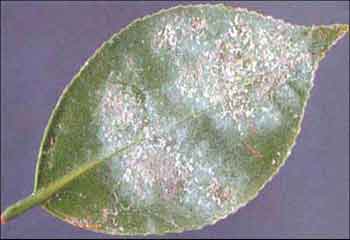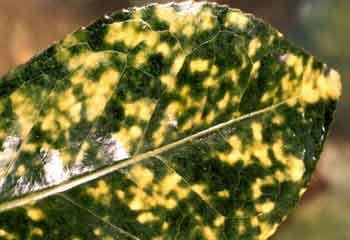Tea scale found in Michigan nursery plants
Nurseries need to check shipments of plants like camellias and hollies that are brought here from southern states for tea scale. Identification, life cycle and control methods to prevent this destructive insect are discussed.

Tea scale, Fiorinia theae Green, is a very destructive pest of camellias and hollies. It is a small scale as the adults are about 0.1 inches long and covered with a hard, brown, wax cover (Photo 1). Males have a white, waxy cover while females are gray to brown. Both usually develop on the undersides of leaves (Photo 2). Leaves infested by this scale will develop yellow blotches (Photo 3) on their upper surface. Crawlers of this scale appear in the spring in the southern states and timing of controls to eliminate this pest are best when either the bloom of honeysuckle or tulip popular starts. This timing can vary, so pay attention to these events if you need to apply a crawler spray.
Another technique to time your crawler spray is to use double-sided sticky tape on several small stems. This tape will catch the tiny crawlers as they emerge and move to another site on the plant. According to Michigan State University Extension, tea scale have multiple generations in southern states, but we probably only have one generation here in Michigan, thus making it easier to control this pest as it probably does not overwinter on plants here.


Photos 2-3. Tea scale on underside of leaf (left) and infested leaves showing damage from tea scale (right). Photo credits: University of Florida (left) and Clemson University - USDA Cooperative Extension Slide Series, Bugwood.org
This being said, if you ship in plants from the south, you need to check them thoroughly for this pest. Check the interior of the plant especially well as the problem may go undetected until the population is heavy. If you find an infestation treatment is critical, be sure to get good coverage on the undersides of the leaves and target the crawler stage to get your best results. Controls include Distance (pyriproxyfen) or 2 percent horticultural oil, timed to coincide with crawler emergence.
Prune out heavy infestations by removing 2- to 4-inch long, non-flowering branches on the major limbs on the plants as these can be locations that are sites where the scale is found. Removal of infested branches is needed to remove even the dead scales as they will remain attached to the plant leaves due to the waxy coating they produce.
For more information, read the University of Florida Extension publication EENY250, “Tea Scale, Fiorinia theae Green.”
Dr. Smitley’s work is funded in part by MSU’s AgBioResearch.



 Print
Print Email
Email



